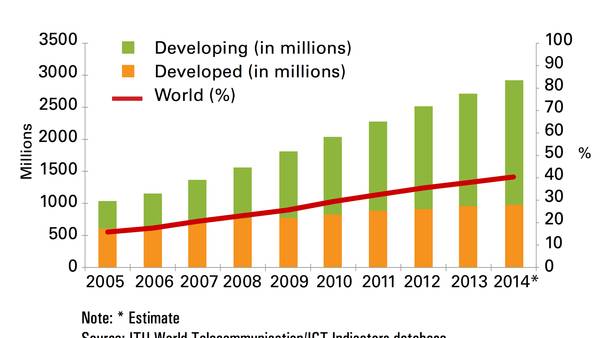The Internet-Divide: 60% of World's Population Still Doesn't Have Internet
By Countercurrents
26 May, 2014
Countercurrents.org

The Internet-divide graph. (UN International Telecommunications Union )
The Internet-divide is very much alive. About 4.2 billion people, 60% of the world population, still don't have internet, said a UN report.
The recently released UN report says nearly 3 billion people will have access to the Internet by the end of 2014.
Two-thirds of these users will be coming from the developing world, and that the number of mobile-broadband subscriptions will reach 2.3 billion globally. Fifty-five per cent of these subscriptions are expected to be in the developing world.
The report says 78% of people in developed countries are expected to have access to the Internet, but in countries that are still developing; the percentage of connected users drops dramatically. In those countries, only 32% of the population is expected to have access to the Internet by the end of the year.
Africa has the lowest percentage of connected people, with only 20% of the population expected to have Internet access by the end of the year. However, Africa is also the region that is having the most rapid growth. In 2010, it was 2% only.
When it comes to mobile access to the Internet, the number of Africa 's mobile-broadband subscribers has a growth rate of more than 40%.
By contrast, 75% of Europe 's population has access to the Internet, the highest. It is being followed by 65% access in North and South America .
The analysis shows that household Internet access is approaching saturation levels in developed countries.
More than one out of two households in the Commonwealth of Independent States (CIS) will be connected to the Internet. In Africa , only about one out of ten households will be connected to the Internet.
More than 90 per cent of the people who are not yet using the Internet are from the developing world.
One-third of the population in Asia and the Pacific will be online by end 2014 and around 45 per cent of the world's Internet users will be from the Asia-Pacific region.
Last year, Facebook formed Internet.org, which is a coalition of companies whose mission is to bring cheap Internet access to everyone in the world. To do this, Facebook spent $20 million this year to acquire Ascenta, a UK aerospace company. The hope is to build drones capable of flying for extended periods of time that can beam Internet access to those below.
Similarly, Google has been working on Project Loon for some time. That effort uses giant balloons to deliver Internet access to users below. Earlier this year, Google also acquired Titan Aerospace, and said the startup, which builds drones, will work closely with Project Loon.
Declining fixed-telephone
Results show that fixed-telephone penetration has been declining for the past five years. By end 2014, there will be about 100 million fewer fixed-telephone subscriptions than in 2009.
Mobile-cellular subscriptions will reach almost 7 billion by end 2014, and 3.6 billion of these will be in the Asia-Pacific region. The increase is mostly due to growth in the developing world where mobile-cellular subscriptions will account for 78 per cent of the world's total.
Mobile-cellular market: Saturation level
Data show that mobile-cellular growth rates have reached their lowest-ever level (2.6% globally), indicating that the market is approaching saturation levels.
Africa and Asia and the Pacific, where penetration will reach 69 per cent and 89 per cent, respectively by end 2014, are the regions with the strongest mobile-cellular growth (and the lowest penetration rates).
Penetration rates in the CIS, Arab States , the Americas and Europe have reached levels above 100 per cent and are expected to grow at less than two per cent in 2014. The region with the highest mobile-cellular penetration rate is the CIS.
By end 2014, fixed-broadband penetration will have reached almost 10 per cent globally.
Forty-four per cent of all fixed-broadband subscriptions are in Asia and the Pacific, and 25 per cent are in Europe .
In contrast, Africa accounts for less than 0.5 per cent of the world's fixed-broadband subscriptions, and despite double-digit growth over the last four years, penetration in Africa remains very low.
Africa , the Arab States , and CIS are the only regions with double-digit fixed-broadband penetration growth rates.
The Americas region stands out with the lowest growth in fixed broadband penetration, estimated at 2.5 per cent and reaching a penetration rate of around 17 per cent by end 2014.
Europe 's fixed-broadband penetration is much higher compared with other regions and almost three times as high as the global average.
Mobile-broadband subscriptions will reach 2.3 billion globally
Globally, mobile-broadband penetration will reach 32 per cent by end 2014; in developed countries, its penetration will reach 84 per cent, a level four times as high as in developing countries (21%).
The number of mobile-broadband subscriptions will reach 2.3 billion globally and 55 per cent of all mobile-broadband subscriptions are expected to be in the developing world.
Mobile-broadband penetration levels are highest in Europe (64%) and the Americas (59%), followed by CIS (49%), the Arab States (25%), Asia-Pacific (23%) and Africa (19%).
Comments are moderated

